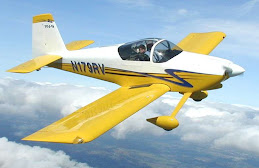Wednesday 12th March 2008 3hr 30 min
Rivetted E-910 reinforcing plates, platenuts, E-905/E-906 root rib and WD-605-R/L elevator horn weldments to the E902 left and right elevator spars. Rivetted E907 trim spar and E-921 Gusset to the E-905 left elevator root rib.
I got some advice from Glenna in Isham inc (http://www.planetools.com/) about my air squeezer problem. She said rivet call-outs can be wrong on Vans plans. Because the squeezer only develops full pressure right at the end of the stroke, if the rivet is too long, the moving die meets the rivet and is stopped before this full-power stage of its stroke. This is correct and it was contributing to the problem but it was not the main cause. At the time, I was trying to set a shop head inside and below the flange of the elevator spar, which is a channel section. For some reason, I wanted the body of the squeezer and the moving dimpled die on the 'outside' of the channel section (instead of reversing the dies and using the squeezer from the inside) so I needed the flat die to stand out sufficiently from the yoke to clear the flange when the squeezer was closed. . Given what I was trying to do, the ideal tool would have been a longeron yoke but I tried to replicate the effect by choosing my tallest flat die and shimming it out further with shim washers. The result was that the dies were closing on the rivet long before the moving set holder had reached the full-powersection of it's stroke. the solution was simple - choose the next shortest rivet, reverse the dies so that the dimpled machine head die goes on the flat 'outside' of the channel, close the trigger gently to ensure the flat die is centred on the unformed shop head as it closes and voilá the perfectly set rivet every time!
Since this episode, I have been doing little calculations to check that the correct length of rivet is being called - my whiteboard is covered with them. Later, I got wise and began to use the rivet guage that came with the tool kit.
skip to main |
skip to sidebar

Factory prototype of the taildragger RV-9

Progress
- Total Cost to date: €9536
- Total time to date: 609hr 12min
- Of which: Empennage: 280hr 35min
- ..............Wings: 326hr 37min
The Vision

Factory prototype of the taildragger RV-9
Blog Archive
-
▼
2008
(64)
-
▼
March
(16)
- Elevators to rudder
- Elevation
- On to the Vertical Stabiliser!
- First main assembly completed - at a cost!
- Easter bonnet
- Nose out of joint
- Good Friday
- First Inspection
- St Patricks day parade
- Counterbalance & corrections
- The Bends at the Ends
- Rivetting Performance!
- Elevation
- Rudder Assembly
- First Rivets!!!
- Practice makes perfect
-
▼
March
(16)

About Me
- Loman O'Byrne
- Dublin, Ireland
- It's a little embarrasing isn't it. I mean men in their 50s should know better than to spend large amounts of money on fantasy (vanity?) projects like this. They should have more sense than to indulge their raging mid-life crises. They should devote themselves to their managerial state-sector jobs. They should prioritise their wife and two kids, even though the kids are almost grown up. They should not undertake complex engineering projects when they have no engineering background and only average DIY skills. They shouldn't take over half of their tiny back gardens to build a workshop that's not even big enough for the project. They should take more interest in other leisure pursuits like golf and following rugby football. They.... I know, I know, I know....but I just gotta!
No comments:
Post a Comment